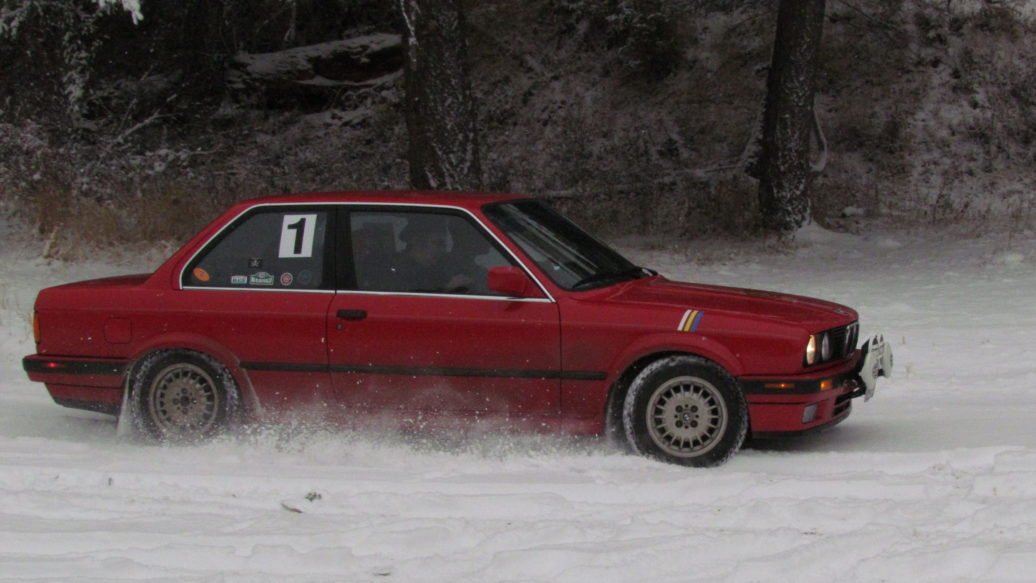There’s been white stuff piled up along my driveway for months now–but the accumulation of those piles was due more to a slow melt rate than to a fast fall rate. So far the snow has come in twenty smallish doses, an inch or five at a time—enough that you can’t trust the dry wind to sublimate it, so you’ve got to plow the drive first thing in the morning to head off any chance of a vehicle crossing it. Otherwise, the tires press each contact patch very firmly into the carpeted icy crystals, squishing out the extra air, and triggering a state change in the snow that must be a hoot to watch if you’re a few microns tall. Imagine, on that tiny scale, watching as the dendritic arms of the snowflake crumble and crash into the already-wrecked arms of their fellows, then crowd in with those fellows tight enough that the crystals reform. It’d be like seeing the wall of a titanic iceberg jut out from Greenland with supernormal speed.
Anyway, don’t drive on snow up here if you want to see the underlying pavement before June. Tire tracks become petrified rivulets of water, locked to the surface below with as much traction as you’ll ever see. That tenacious grip of ice-to-pavement makes me think: Maybe we should be driving on ice tires—that is, tires made from ice, not tires made to drive on ice—if only we could automate the un-freezing/re-freezing of the ice-tire’s tread in just the right way. Willikers, I’m off track again.
Unlike the previous snowfalls, the recent snow was Big Snow—not, for these parts, a record, nor even top ten. But the storm sat over us for about 40 hours, and its skill was at least Journeyman level, so the storm’s output over that period commanded respect. Now we were plowing not to prevent ice formation, but just to be able to drive out if there was an emergency. Four times we plowed, four times the storm blithely repainted our grounds in white velvet. We got tired before it did—but then, we didn’t have the power of the Gulf of Mexico shoving us northwest, as the storm did.
Then, like a fetching horse who knows you can’t stop watching him, the storm sidled away, probably towards Indiana. A truly wild horse would have gone north, to the equine paradise of the Dakotas, so we have further proof that this storm likes attention and would never retire on a ranch at the penultimate sideroad—not the end of the road, to avoid the annoying turners-around who disregard the DEAD END signs and proceed until they can no farther—somewhere in Montana. In any case, the storm finally moved on, and we caught up on driveway clearing.
Right. So where’s the car stuff?
One of the best times to practice winter driving is in winter. More cautious or more intelligent than I, the majority of this mountain community stays the hell home during the storm, and waits for the passage of the county plows before venturing out. This leaves the roads empty of humans, and the mule deer are likewise absent, likely hunkered down under some conifer, ruminating and straining to hear things.
But for me, deserted roads are an invitation to carve fresh tracks and experiment with car control at relatively low speeds and energies—or, when the way is clear, to reacquaint oneself with what maximum braking on downhill off-camber turns is like.
I recall so very many rallies in British Columbia where the snow level–and texture–had not been anticipated by the rallymaster. No one could have foreseen the conditions, really, with the deadlines for pre-running and printing always tight. And since the only thing worse (for a rallymaster) than setting the CAST too high is to set the CAST too low. Either way, you’ll get a reputation, but the rep for the first kind of error carries a warmer feeling than the latter. You could err a bit too high–the drivers will love you–or you could err too low, in which case all competitors will hate you (for boring them). When errors of the high side are made, the competitors are challenged to exceed their limits; not and never in a way which threatens health, of course: any good TSD rally provides for “time declarations” by the competitors in order to deal with delays. The too-high error is simply nature and circumstance raising the bar; it is for the teams to try to clear it.
On those rallies, my snow driving proved “within acceptable limits,” but there was a related road-surface condition that exposed a shortfall of my skills: Slimy Mud. My co-driver and I were leading the Thunderbird Rally—a miracle of sorts because there are always a dozen teams that could win it. But we were ahead on Sunday morning, by the tiniest of margins, and it’s important that we ran the final day in top form. But the night before there had been snow, and by midday its melting made mud.
And the memory of that mud still echoes.
In the car, we assumed a routine: turn the wheel, front tires push, car mildly slides, careful tweaking straightens us, and we’ve lost a couple of seconds. This went on for many minutes, while a creeping tension filled the cabin. I knew that we were down; my co-driver knew we were down; what my co-driver didn’t know was that try as I might, I couldn’t get the time back. The sliding around took us down to second place, and we had to again talk of “maybe next year.”
I needed more practice on mud.
Well, this year the melt of that Big Snow has made some absolutely delicious mud to practice in. Just don’t let your pant legs touch the door sills when you get out of the car.—Marinus Damm
[Photos courtesy Ron Sorem and Tony Latham.]






















